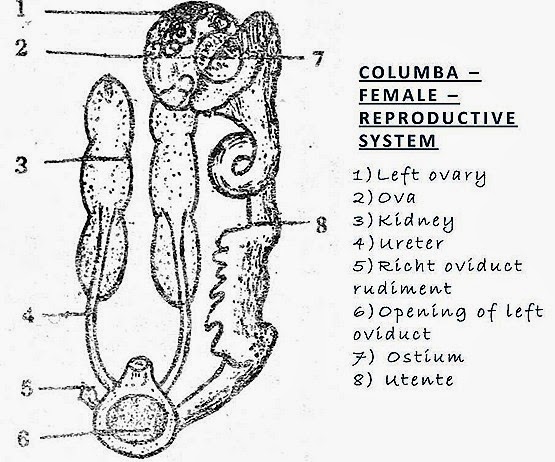FEMALE REPRODUCTIVE SYSTEM OF BIRD-RABBIT-REPTILE-COMPARISION
FEMALE REPRODUCTIVE SYSTEM OF CALOTES (LIZARD) VS
FEMALE REPRODUCTIVE SYSTEM OF COLUMBA (PEGION )VS
FEMALE REPRODUCTIVE SYSTEM OF RABBIT-MAMMAL)-COMPARITIVE ANATOMY
Reptile -bird-mammal-female reproductive organs similarities and differences in glance in a table

| FEMALE REPRODUCTIVE SYSTEM- CALOTES | FEMALE REPRODUCTIVE SYSTEM- PEGION | FEMALE REPRODUCTIVE SYSTEM- RABBIT |
| 1, On the right and left sides two ovaries are present. | 1. Only left ovary is present. A vestige of right ovary may occur. | 1. A pair of ovaries are present on the left and right sides. They are small and compact bodies. |
| 2. Ovaries are irregular bodies situated assymetrically and hanging from the dorsal wall of the body cavity by mesovaria. | 2. The single left ovary is attached to anterior lobe of the left kidney by mesovarium. | 2. The ovaries lie behind the kidneys and attached to dorsal wall of the abdominal cavity by mesovaria. |
| 3. Right ovaiy is a little anterior to the left one. | 3. Right ovary is absent. | 3. Right and left ovaries are at the same level. |
| 4. Oviducts are paired. | 4. Only left oviduct is developed. A vestige of right oviduct is often seen. | 4. Oviducts are paired. |
| 5. Oviducts give striated appearance over greater part of their length. | 5. Oviduct doesnot give striated appearance. | 5: Striated appearance is absent. |
| 6. Oviducts extend well ahead of ovaries and follow straight course. | 6. Oviduct starts'just behind the ovary and follow a convoluted course. | 6. Oviducts start just outside the ovaries and follow convoluted course. |
| 7. Oviducal funneb are large and have externally directed ostia with the entire margin. | 7. Single Left oviducal funnel is very large and membranous. It has fimbricated margins it lies close to the ovary with it; ostium. | 7. Oviducal funneb are small and have internally directed ostia with fimbricated margin. |
| 8. Each oviduct dilates to form an oval shell gland along the ventral surface of the kidney uteri are not demarcated. Oviducts are enlarged into small ovisacs. These are two vaginae. Vaginae open into the urodaeum. | 8. The oviduct is divided into anterior oviducal funnel, behind it magnum which is thick walled & secretes albumen. Below the Magnum is isthmus which secretes shell membrane and the succeeding part is the uterus. Uterus is thin walled and secretes calcareous shell and albumen. The posterior most part is the thick walled and mus-cular vagina. | 8. The oviducal funel leads distaliy :uio a bng, narrow and convoluted tube - Fallopian tube. Its walls are lined with Ciliated epithelium. The posterior most parts of the two oviducts form uteri. These are widened muscular and»/ascular structures. The paired uteri open into median and highly muscular chamber-vagina. Associated with urethra, the vagina forms the urino-genitaf canal or vestibule. |
| 9. Urodaeum opens outside by a transverse cloacal aperture. | 9. Urodaeum opens out by a transverse cloa-cal aperture. | 9. Urino - genital canal opens outside by a longitudinal aperture - vulva lying infront of the anus. Vulva has 'clitoris.' |
| 10. There are no special glands associated with female reproductive system. | 10. Same as in calotes. | 10. Cowper's and perineal glands are associated with female reproductive system. |
| 11. Milk glands are absent. | 11. Milk Glands are absent. | 11. On the ventral surface of trunk region 4 or 5 pairs of milk glands open through their tears. |
| 12. Fertilization is internal oviparous animal. | 12. Same as in calotes. Oviparous animal | 12. Same as in calotes and columba. Viviparous animal |

